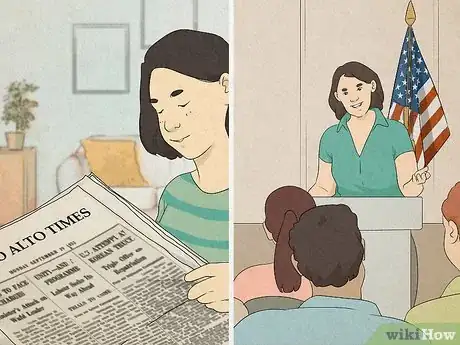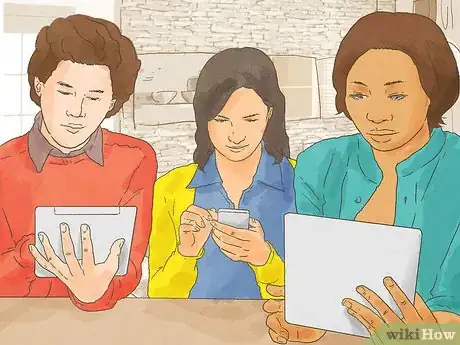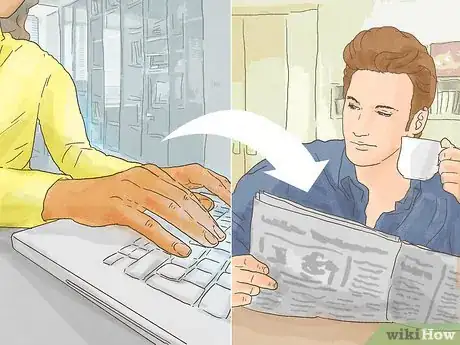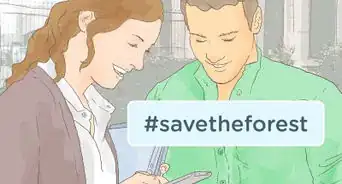This article was co-authored by wikiHow Staff. Our trained team of editors and researchers validate articles for accuracy and comprehensiveness. wikiHow's Content Management Team carefully monitors the work from our editorial staff to ensure that each article is backed by trusted research and meets our high quality standards.
This article has been viewed 23,635 times.
Learn more...
If you wish to conduct a local petition drive in your community, you will need to begin by understanding the issues and how they affect people in town. With a little understanding, you can develop a petition, gather community support, and then conduct a petition drive to collect signatures. In this way, you can bring about change that you believe is important for the good of your local community.
Steps
Measuring Community Opinions
-
1Understand the issues in your community. For a local petition drive, you will need to begin by understanding the important issues in your community. Read your local newspapers. Attend sessions of your city council or other local legislative body. Find out what people are saying or thinking about your issue.
-
2Talk to community leaders and politicians. As you narrow your focus on your topic, contact leaders in your community to learn more. You should identify those people who may have some influence over your particular topic. You also need to learn what steps may already be in place to address the changes you have in mind.
- For example, if you are concerned with some issues relating to the use of public parks in your community, you may not need to start by talking with the mayor of your city. You might get more direct attention and positive results by speaking with the director of the Parks Department.
- Ask these leaders if anyone has identified the same problem that you see. Find out if they are doing anything about it or if they have any plans to address the problem in the future. If they appear receptive to making change, then you may not need a petition. However, if you find that they do not seem to care, then the petition drive may be needed.
Advertisement -
3Discuss the issue with friends and neighbors. As you identify a problem area, discuss it with people you know in town. Find out if they share your concerns. You won’t want to spend a great deal of time on a petition drive if you are not already confident that a need exists and people share your opinion.
- At this level, your conversations can be fairly informal. Just ask, "What do you think about the noise levels on Friday nights? Don't you agree that we should try to get the city to do something about it?" You could start sharing some data and information on the topic, if you have it.
-
4Organize discussion groups. You may want to organize small community gatherings or discussion groups to talk about the problem. Invite some friends to your house or see if you can use a local church, library or community center to hold a small meeting. The purpose of any such meeting will be to discuss the problem and gauge the level of interest and concern among other community members.
- If possible, invite relevant community leaders to attend. For example, the Director of the Parks Department might come to talk about new regulations for dog walking in public parks.
- You can start a meeting like this with, "I have asked you all to come together to discuss our need for another library branch in this town. I think we need someone to take action, but I want to hear what you think." As the discussion goes on, you can then begin measuring support for a petition drive by asking, "How many of you would be willing to help me gather signatures to show the city that we are serious about this?"
-
5Find out what is already being done. Ask whether the city is taking any steps already focused on the problem you have identified. You don’t want to waste time preparing a petition and then starting a signature drive, only to find out that the city has already reviewed the issue and plans to start some changes in the near future.
Drafting a Petition
-
1Generate an effective title. The first thing people will see and hear is the title of your petition. If you use something that attracts attention, you can get more people to stop and agree to sign. Keep your title brief and use strong verbs that tell people what you want to do.[1]
- Some examples of powerful petition titles are, "Stop Torturing Chickens for McNuggets" or "Donate Recalled Cheerios to Those in Need."
-
2State your position clearly and emphatically. You need a few statements that clearly explain what you want to change in your community. People who sign it and the leaders who will receive it need to understand exactly what you want. You may begin, for example, with a clear statement like, “We, the undersigned petitioners, believe that Smallville needs a separate park where dog owners can allow their pets to run freely. We call on the City Council to identify a location and provide fencing for such a park.”[2]
-
3State the reasoning for your position. You need to give the community leaders a reason for what you want. A long list of signatures is powerful, but strong reasoning can be even more persuasive. If you have any research or examples of other communities that have taken similar action, provide this information.[3]
- You may say something like, “Several surrounding communities, including Gotham, Silver City, and Old York have created dog parks within the past two years.”
- You might also include persuasive statistics or data, such as, “Communities that have created designated dog parks have seen a 10% decrease in incidents of dog bites.”
-
4Find out if a specific form is required. Some jurisdictions will only accept petitions on an official form. Others will accept any format. You should check with your city clerk or other similar official to find out what is required. If you must use a specific form, ask where you can get it and find out if you are allowed to make photocopies or if you must use only original forms.
-
5Know your community’s rules for presenting a petition. If you only want to present a petition that states opinions, you probably have fewer requirements to follow. But if you are using a petition drive as a way to force a ballot question, for example, you probably have to abide by certain strict requirements. Some of these requirements may include:[4]
- The minimum number of signatures you need for the petition to be valid.
- The use of specific forms or petition sheets.
- Whether you need printed names along with signatures.
- Whether you must include addresses for each signer, or any other information, and whether signers must live within a certain geographical location.
- Deadlines for submitting the petitions to be considered on an upcoming ballot.
-
6Investigate online petition templates. If you search online for "create petition," you will find a variety of free petition services. Some of these provide templates that you can use to draft and print your own petition forms. Some of them actually help you set up your own online petition drive. (You will need to verify that an online petition will be accepted before using this format.)[5]
Conducting a Petition Drive
-
1Determine your goals for gathering signatures. Based on your local rules for petition drives and the size of your community, you will need to establish goals and expectations for gathering names. As a general rule, you should aim to collect up to 50% more names than the minimum requirement.[6]
-
2Get plenty of volunteers to help collect signatures. You cannot expect to conduct a successful petition drive on your own. Determine the number of signatures that you need, and then calculate a reasonable number for each person to collect. Using these figures, you can decide how many volunteers you will need for the petition drive.[7]
- For example, suppose you decide that you want 5,000 signatures for a successful petition drive. A single volunteer might be expected to bring in 500 signatures over the length of your petition drive. This means that you should get at least ten people to help collect signatures.
-
3Give your volunteers the training and materials they will need. Each volunteer will need several copies of the official petition sheet, sufficient numbers of pens to collect signatures, and clipboards. You may also want to set up information stations around town with promotional materials as well. Discuss the cause fully with all your volunteers, to ensure that they all fully understand the issue and are ready to discuss it when they ask people to sign the petition.[8]
-
4Be organized. Your volunteers should not approach the same people repeatedly to gather signatures. Organize the signature drive by giving volunteers assigned locations. These may be fixed stations, such as a table outside the grocery store or train station. You may also assign people to particular streets or neighborhoods to visit door-to-door. It is also a good idea to arrange common times for collecting signatures.[9]
-
5Produce the final product. Collect the completed petitions and deliver them to the appropriate government office. When your petition drive is complete, find out where you need to send the petitions, and have them delivered. If you do not know, you should probably begin by contacting the city clerk’s office for information.[10]
- If your petition is directed to a particular department of your local government, you may be directed to deliver your final copies directly to that department.
Using Local Press and Social Media for Support
-
1Use the Internet and social media. If a member of your group is particularly adept at using social media, you may be able to create an online petition. This would serve to bring wider attention to your issue. It also can reach many people much more quickly than physical contact with volunteers.[11]
- For example, Facebook provides useful materials about creating and marketing an online petition. It provides links to features that help you create a petition, share it with a wide audience, and collect e-signatures without ever having to speak directly with anyone.
-
2Understand the acceptance of e-signatures. Depending on the breadth of your audience and the topic of your petition, an online petition may not be useful. You should check with your local government leaders to find out if they will accept virtual e-signatures from an online petition.
-
3Write editorial letters to the local newspaper. When you know of specific dates that you will be conducting your signature drive, you should notify the local paper. A letter to the editor can both generate support for your issue and advertise your signature drive. Provide information that will help the public find your information stations and that will make them want to sign your petition.
- For example, you could use a brief letter like, “Dear Editor, We have a strong need for a new dog park in our town. Surrounding towns have already recognized the need and have taken action, and we are behind. A group of concerned citizens will be collecting signatures on a petition in front of the train station on Saturday morning from 8 to 12. Everyone is encouraged to come lend their support and sign a petition.”
References
- ↑ https://www.change.org/start-a-petition
- ↑ http://ctb.ku.edu/en/table-of-contents/advocacy/direct-action/petition-drive/main
- ↑ http://ctb.ku.edu/en/table-of-contents/advocacy/direct-action/petition-drive/main
- ↑ http://ctb.ku.edu/en/table-of-contents/advocacy/direct-action/petition-drive/main
- ↑ https://www.change.org/start-a-petition
- ↑ http://ctb.ku.edu/en/table-of-contents/advocacy/direct-action/petition-drive/main
- ↑ http://ctb.ku.edu/en/table-of-contents/advocacy/direct-action/petition-drive/main
- ↑ http://ctb.ku.edu/en/table-of-contents/advocacy/direct-action/petition-drive/main
- ↑ http://ctb.ku.edu/en/table-of-contents/advocacy/direct-action/petition-drive/main









































































